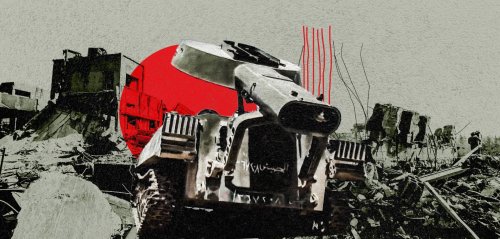"The world is now officially free from chemical weapons" – a phrase that can be hard to fully grasp, even though it took center stage in a news report on the American National Public Radio. This came after the United States made an official announcement regarding the complete destruction of its stockpile of chemical weapons, becoming the final nation among the eight originally possessing such armaments to fulfill its commitment under the Chemical Weapons Convention (CWC). This achievement was accomplished at the Blue Grass Army Depot in Kentucky earlier this month.
With the disposal of the last sarin gas missile, Kingston Reif, Deputy Assistant Secretary of Defense for Threat Reduction and Arms Control, presiding over the operation, declared, "The destruction of this individual missile means that 100% of the declared chemical weapons in the world have now been destroyed," as reported by the National Public Radio.
This new reality opens the door to revisiting a dark Arab history concerning the use of such weapons, where some countries in the region used these weapons in their conflicts. The list is not short, and here we aim to review and document some of these events
The reason for the delay in the disposal of these weapons
The United States stands as the last country to eliminate its chemical weapons, having gone past the previously-set deadline by 10 years from the initial signing of the treaty in 1993, after which the deadline was extended until April 29, 2012. However, the United States faced delays in fulfilling its promise, leading to a postponement until the sixty-eighth session of the Executive Council of the signatory states, as conveyed by the Organization for the Prohibition of Chemical Weapons (OPCW).
David Koplow, a law professor at Georgetown University in Washington, DC, attributes the reason the United States took so long to dispose of the chemical weapons to the difficulty in handling them. These weapons contained lethal chemicals and explosives tightly packed into shells, missiles, or bombs, making them unsuitable for conventional dismantling. Additionally, many of these weapons were manufactured decades ago and weren't designed to be dismantled, rendering them fragile and unreliable. Consequently, the development of new techniques became essential to avoid the risk of dangerous contamination during the disposal process. He also highlighted the program's challenges, including funding shortages and inadequate management.
In his analysis, he remarked, "The program's leadership changed frequently, and it wasn't given the seriousness it deserved. As a result, the process went on for a long time, with the United States violating the treaty for many years."
The convention
In 1993, approximately 193 countries joined the Chemical Weapons Convention, which prohibits the use of toxic properties of chemical substances like chlorine and sarin gas for lethal purposes. Each nation pledged not to engage, under any circumstances, in "to develop, produce, otherwise acquire, stockpile or retain chemical weapons, or transfer, directly or indirectly, chemical weapons to anyone.. or assist, encourage or induce anyone to engage in any activity prohibited under this Convention", and they were required to destroy their chemical arsenals by 2007, with an option for a one-time extension of five years, according to the Arms Control and Disarmament Center.
When the convention came into effect, there were around 30,072 metric tons of declared toxic chemicals in 8.6 million containers that required destruction in signatory states. To date, over 98.5% of all declared chemical weapons have been destroyed. Egypt, Israel, and North Korea remain outside the convention, while eight countries have declared chemical weapons stockpiles, including Albania, India, Iraq, Libya, Syria, the United States, Russia, and an unidentified country widely believed to be South Korea.
According to declassified US documents, the West supported Saddam Hussein's regime in using chemical weapons during the Iran-Iraq War. "Despite the Geneva Protocol banning their use, the West supported Iraq's use of chemical weapons to keep Iran from victory"
Arab countries that have used chemical weapons
The recent US announcement and the changing reality open the door to revisiting a dark Arab history concerning the use of such weapons. Some countries in the region deployed these weapons in their Arab-Arab or Arab-non-Arab conflicts and wars. Moreover, certain regimes, both past and present, have used this type of armament against their own citizens. The list is not short, and here we aim to review and document some of these incidents.
We start with the Iran-Iraq War, when Iraq employed chemical weapons against Iran between 1980 and 1988, during the First Gulf War. According to declassified documents from the research lab at the National Archives in College Park, Maryland, the West supported Saddam Hussein's regime in using chemical weapons during this conflict. At the time, official reports indicated that the Iraqi army utilized chemical weapons in attacks against Iranian military forces and civilians in border cities and villages, with over 30 attacks on civilians. There were also other chemical attacks by the Iraqi army on certain Iranian medical centers and hospitals. A 2002 article in the Star-Ledger newspaper stated that "approximately 20,000 Iranian soldiers were immediately killed due to exposure to nerve gas, and 5,000 survivors continue to receive medical treatment. Despite the Geneva Protocol banning the use of chemical weapons in international armed conflicts, the West supported the Iraqi army's use of chemical weapons to keep Iran from victory."
During that period, the city of Halabja in the Kurdistan region of Iraq experienced a horrific chemical bombing on the morning of March 16, 1998 that led to a massacre. At that time, the Iraqi army, under Saddam Hussein's orders, bombarded the city after Iranian forces advanced to invade the Iraqi border and reached Halabja. The Saddam Hussein regime accused the city's inhabitants of facilitating the entry of Iranians, resulting in the deaths of between 5,000 and 9,000 victims, including Kurdish civilians, children, and women. After this attack on the Kurds, Saddam Hussein's regime faced widespread international condemnation.
Iraq had a three-phase program for manufacturing chemical weapons from the beginning of Saddam Hussein's rule. The program commenced with production and procurement between 1981 and 1984, starting with initial experiments and manufacturing. It culminated in the use of these weapons during the Iran-Iraq War, followed by extensive production to supply the Iraqi army. The production took place at the Al-Rashad Facility and the Al-Samara Complex, with storage at depots such as Al-Muthanna in Fallujah, as documented in a 2006 Security Council memorandum outlining Iraq's lengthy process of purchasing and manufacturing chemical weapons.
Iraq began a 3-phase program for manufacturing chemical weapons at the start of Saddam Hussein's rule, with production and procurement between 1981 and 1984, then initial experiments and manufacturing, and mass production to use them during the Iran-Iraq War
Iraqi doctor and researcher Abdul Razzaq Abdul Jalil Issa, in an article published in Al-Mada Iraqi newspaper, stated that: "In 1991, Iraq agreed to UN Security Council Resolution 687 (1991). The resolution required Iraq's unconditional acceptance of international supervision for the destruction of all its chemical and biological weapons, including related components, sub-systems, and research, development, support, and manufacturing facilities. Between 1992 and 1994, more than 30,000 different ammunition pieces and approximately 480,000 liters of chemical agents, along with over two million liters of precursors, were successfully destroyed." However, the manufacturing practices adopted by Saddam Hussein provided a pretext for the United States' invasion of Iraq.
In 2009, Iraq joined the Chemical Weapons Convention. The largest stockpile of chemical weapons caches and related equipment and debris from the 1991 Gulf War were stored in the Muthanna facility in the Fallujah area. It was previously occupied by the Islamic State in 2014, which raised concerns for the United States. Yet, the facility was reclaimed by the Iraqi army in 2015. At that time, the Iraqi Foreign Ministry asserted that the materials inside posed no threat. Subsequently, after joining the convention and concluding its war against the terrorist organization, Iraq commenced destroying weapons storage and production facilities. In 2018, the Organization for the Prohibition of Chemical Weapons confirmed that Iraq had completed the destruction of its chemical weapons.
Libya in Chad and Iran's involvement
Throughout the 1970s and 1980s, Libya sought control over the mineral-rich Aouzou Strip along its disputed border with neighboring Chad, leading to intermittent wars and confrontations with both France and the United States. In 1987, Libyan forces gained the upper hand over Chadian forces after using chemical weapons during Muammar Gaddafi's rule. After 24 years, former US Secretary of State Mike Pompeo revealed, via his official Twitter page, that "the United States declassified documents related to Iran's use and trafficking of chemical weapons during the Libya-Chad war" between 1978 and 1987, and that following Gaddafi's downfall, chemical weapons with Persian writings were discovered. For its part, Iran denied any involvement in sending chemical weapons to Libya.
Due to international pressure, Gaddafi agreed in 2003 to join the Chemical Weapons Convention in exchange for "rapprochement" with Western countries. Yet, according to a 2016 BBC article titled "Libyan Chemical Weapons: The Final Components for Destruction," the Libyan government did not fully destroy its stockpile. Approximately 11.25 tons of toxic mustard gas remained, intended for potential use against hostile states or those seeking to destabilize the region, according to the Arms Control Association.
Nevertheless, the Organization for the Prohibition of Chemical Weapons reported in 2011 that Libya (in 2004) had destroyed its stockpile of air-delivered bombs, which could have been used to deliver chemical agents. This was part of an agreement reached between Gaddafi and the West for dismantling his weapons of mass destruction program. The report also indicated that Tripoli had destroyed almost 45% of its stockpile of mustard gas in 2010 and agreed to destroy the remainder by May 2011. Libya also destroyed approximately 40% of its stockpile of sulfur mustard in 2005.
After the events in Libya and the fall of Gaddafi's regime, international bodies sought cooperation with Libyan officials to ensure Libya's commitment to its obligations under the treaty. The National Transitional Council collaborated with the Organization for the Prohibition of Chemical Weapons to destroy all chemical weapons in the country. The organization periodically verified this, and in 2016, Libya declared the removal of any remaining chemical weapons from its territory with the aim of destroying them.
Egypt has made significant strides in manufacturing chemical toxins in an extensive program to produce chemical weapons. CIA and MI6 reports indicate Egypt establishing multiple factories for chemical warfare agents in the western areas of Cairo and the Delta
Egypt and the Yemen war
Egypt remains the only Middle Eastern nation yet to join the Chemical Weapons Convention. However, it was the first country in the region to possess such weapons, including training and raw materials. It also possessed chemical weapons with the launch of the Dimona reactor in Israel in 1958. These weapons are among the most prominent strategic weapons in the Egyptian army, according to the Arab Defense website, where Egypt subsequently employed chemical weapons during the Yemen War in 1967. Specifically, mustard gas was used in strikes against rebels in the northern parts of Yemen, marking the initial instance of chemical weapon use in the Middle East and resulting in the loss of 14,000 lives.
According to the Arab Defense website, Egypt has made remarkable progress in the manufacturing of chemical weapons and toxins, with the establishment of numerous factories in the western parts of Cairo and the Delta. Reports from the CIA and MI6 indicate that the Abu Zaabal Chemical Plant served as the main front in Egypt's expansive program dedicated to producing chemical weapons. Additionally, the military possesses exclusive factories and facilities where civilian access is restricted. There is also the potential for converting certain production lines in pharmaceutical and insecticide chemical plants for the creation of chemical warfare agents.
The Western Desert stands as "one of the key locations for stockpiling chemical ammunition, hosting the primary storage for Egypt's military ammunition depots through a network of concealed tunnels that satellite imagery could not locate, along with specific areas in the western regions of the Suez Canal." This was confirmed by Osama El-Baz, former office director for President Hosni Mubarak, in 1999, stating that "Egypt possesses the capability to deter Israel and has sufficient means to achieve such deterrence." Elaborating on this stance, he emphasized the necessity for Egypt to possess weapons and means to safeguard its sovereignty and national security, particularly in response to Israel's nuclear program and development of chemical and biological weapons. Haaretz, the Israeli newspaper, echoed this sentiment, noting that "Egypt threatens to arm itself with chemical and biological weapons in response to Israel's nuclear arsenal."
America's rich history in chemical warfare
The United States has had a long history with chemical weapons, deploying them in wars, conducting human experiments, and incorporating them into training exercises.
The US has had a long history with chemical weapons, deploying them in wars, conducting human experiments on unsuspecting civilians, and incorporating them into training exercises.
Disturbingly, during the Vietnam War from 1955 to 1973, it is estimated that the US disposed of approximately 20 million gallons of chemical substances, including prohibited chemical weapons, as documented by the American PBS. Moreover, for a considerable period, these weapons were used by the US Army Chemical Corps, which clandestinely carried out experiments to study how chemical particles disperse in the atmosphere. The History Collection website reports that spraying devices were surreptitiously placed on residential buildings, schools, and even vehicles, notably the Pruitt-Igoe housing complex. Tragically, this complex was home to around 10,000 residents, of whom a staggering 70% were children under 12 years old. At the time, the people were informed that the army was merely testing a defensive smoke screen in the event of a potential Russian invasion. However, the truth came to light when declassified documents revealed that the substances released in the area, described as a "densely populated, randomly chosen area," were, in fact, a chemical weapon comprised of zinc cadmium sulfide and a compound known as FP2266, suspected to be radioactive. This alarming experiment took place between 1963 and 1965 and was finally uncovered in 1994.
Raseef22 is a not for profit entity. Our focus is on quality journalism. Every contribution to the NasRaseef membership goes directly towards journalism production. We stand independent, not accepting corporate sponsorships, sponsored content or political funding.
Support our mission to keep Raseef22 available to all readers by clicking here!
Interested in writing with us? Check our pitch process here!









